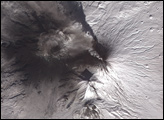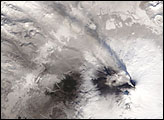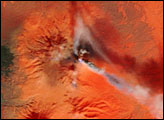

In late February and early March 2005, the Shiveluch and Klyuchevskaya Volcanoes on the Kamchatka Peninsula in northeastern Russia seemed to take turns at generating dramatic eruptions. This image from the Moderate Resolution Imaging Spectroradiometer (MODIS) on NASA�s Terra satellite shows the two volcanoes on March 5, 2005. Snow and ice are red, while clouds are white or peach colored.
According to reports from the Volcano Live Website, Klyuchevskaya Volcano was ejecting volcanic bombs several hundred meters into the air, and lava was flowing down the western slope of the mountain. As the scorching lava comes in contact with the snow and ice on the mountain the lava has been exploding and producing ash. Since it began in late February, the lava flow has widened and is claiming more and more of the Ehrman Glacier. In this image the thermal signature from the crater is outlined in red, while what appear to be black shadows cover the northern and western flanks of the volcano. It is possible that these are mud and meltwater flows. An arm of these shadowed areas reaches northward into the valley between Klyuchevskaya and Shiveluch.On the southwestern flanks of Shiveluch, a trail of light blue probably marks the path of a pyroclastic flow. On February 28, a large ash cloud erupted from the summit of Shiveluch, spreading hundreds of kilometers westward and covering thousands of square kilometers with a layer of ash up to 8 centimeters deep in places, according to reports from volcano monitoring networks. The Shiveluch seismological station stopped recording data, and it was probably destroyed by a 10-kilometer-long pyroclastic flow that poured down from the volcano�s summit.
Image courtesy the MODIS Rapid Response Team, NASA-Goddard Space Flight Center
Eruptions at the Klyuchevskaya Volcano are becoming increasingly violent, prompting officials to raise the volcanic alert to its highest level, reserved for major explosive eruptions. (The volcano's name has many alternate spellings, including Klyuchevsky; Kluichevsky and Kluichevskaya; and Kluichevskoi.)



